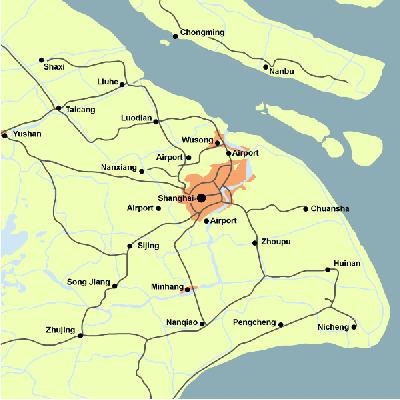| Map |
|
Shanghai Geography
Geography
Shanghai has a sub-tropical climate--mild and humid with four distinct seasons. It has a mean annual temperature of 15oC -- the hottest month, August, averaging 28oC and the coldest month, January, 3oC -- and a mean annual precipitation of 1,100 mm. It is often visited by typhoons between summer and autumn.
Shanghai is divided into 18 districts and 1 county, with a population of over 16.74 million people.
Huju opera, Yueju opera, burlesque, Pingtan opera
Shanghiai food is one of the Eight Great Cuisines in China. "Braised Meat" is one of its dishes with special flavor; the meat is cooked with different spices for a long time to absorb the flavor of spices and is tender when it is ready.
Shanghai, "Hu" for short, is one of the four municipalities directly under the Central Government. During the Warring States Period (475-221BC), Shanghai first belonged to the Yue State, then to the Chu State. King Lie of the Chu State appointed Huang Xie as his prime minister and bestowed him the title of Lord Chunshen. Shanghai was part of his feoff. The old name of Shanghai "Shen" was derived from this.
The name "Shanghai" actually came during the Song Dynasty (960-1279), when Shanghai became a new rising trade port. The mother river Huangpu River, which runs through Shanghai and empties into the Yangtze River, has 18 creeks and one of the creeks was called "Shanghai Creek" -- near the Bund, thus the town nearby was called Shanghai Town. Later this whole area is named "Shanghai". By the Ming Dynasty (1368-1644), Shanghai became China's largest textile center and business was developing fast.
After the Opium War in 1840, Shanghai was opened as a trade port to foreign powers that set up their concessions there through imposing unequal treaties on China. In the century or more that followed, Shanghai became the largest base of imperialist aggression in China, known in the West as an "adventurers' paradise".
A city with a glorious revolutionary record in modern Chinese history, Shanghai was where the Chinese Communist Party was founded in July 1921. On July 7, 1927, Shanghai was proclaimed as a special municipality. On May 27, 1949, Shanghai was really liberated.
Nowadays, Shanghai is the biggest city and the largest commercial and financial center in China. It is an important hub of communications with an easy access to the outside world by all means of transport: ocean, offshore and inland water shipping, highway and railroad transport, air flights etc. Via the Yangtze River and the Huhang (Shanghai to Hangzhou) and Jingguang (Beijing to Shanghai) Railways, it becomes the communication hinge connecting all parts of China. As the biggest seaport in China as well as one of the ten largest seaports in China, the port of Shanghai has trade links with ports of over 100 countries and regions. It also has over 40 inland and international airlines, connecting it with inland big cities as well as international cities like Tokyo, Osaka, Bombay, Athens, Geneva, Zurich and Karachi. About one third of external communication of China is transmitted by Shanghai Satellite Ground Station and Sino-Japanese Benthonic Cable.
As the biggest industrial center in China, Shanghai ranks first in industrial production as well as scientific and technological level. Its coastal area abounds in resources of fish and salt.
Shanghai is situated at the delta of the Yangtze River, guarding the gateway of the Yangtze River in the north, facing the sea in the east and bordering the scenic city of Hangzhou Bay in the south. It is one of the six best travel sites in China. With its abundant beautiful gardens, cultural relics, museums and temples, Shanghai attracts thousands of visitors both at home and abroad every year.
The Site of the First Congress of the Communist Party of China The Oriental Pearl Tower Jade Buddha Temple (Yufosi) Longhua Pagoda and Longhua Temple Former Residence of Lu Xun, Lu Xun's Tomb, and Lu Xun Museum Yu Garden Nanjing Road The Bund |
||||
 |
